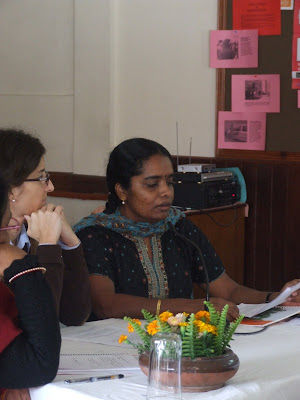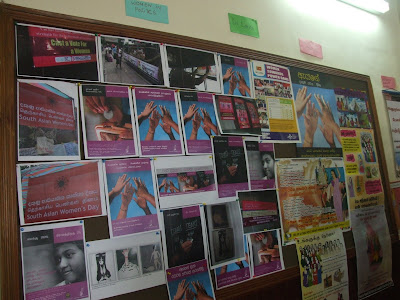Women Waging Peace ~ Lived Experiences from Sri Lanka
Women as Peace Makers

DushiYanthini Kanagasabapathipillai is making her presentation ~ "Women Waging Peace"
United Nations Security Council Resolution 1325 Paragraph 8(b) states “Recognising women’s day today interventions in responding to conflict and promoting peace ~ supporting and sustaining this work”.
Women have proven time and again their unique ability to bridge seemingly insurmountable divides. So why aren’t they at the negotiating table?.International organisations are slowly recognizing the indispensable role that women play in preventing war and sustaining peace. The role of women as peacemakers can be expanded in many ways.
A U.N. official once stated that, in Africa, women are often excluded from negotiating teams because the war leaders “are afraid the women will compromise” and give away too much.
“Women are often the most powerful voices for moderation in times of conflict. While most men come to the negotiating table directly from the war room and battlefield, women usually arrive straight out of
civil activism” according to Swanee Hunt, Lecturer in Public Policy at Harvard University's Kennedy School of Government.
On 31st October 2000, the United Nations Security Council issued Resolution 1325 urging the Secretary ~ General to expand the role of women in U.N. field-based operations, especially among military observers, civilian police, human rights workers, and humanitarian personnel.
In November 2000, the European Parliament passed a hard ~ hitting resolution calling on European Union members (and the European Commission and Council) to promote the equal participation of women in diplomatic conflict resolution; to ensure that women fill at least 40 percent of all reconciliation, peacekeeping, peace-enforcement, peace building, and conflict-prevention posts; and to support the creation and strengthening of ngos (including women’s organizations) that focus on conflict prevention, peace building, and post ~ conflict reconstruction.
Women for Peace
In Sri Lanka’s history, women were very active in anti imperialist struggles. For example in 1933, women launched the Suriyamal movement against the Armistice Day or Poppy Day where poppies were sold to raise funds for the British Soldiers. The 1980s saw the coming together of women’s coalitions against the war. One of the first such women’s coalitions to be formed around the ‘national question’ was the Women’s Action Committee (WAC). The WAC also took up the call for the release of Tamil political prisoners and worked closely with the Movement for Inter Racial Justice and Equality (MIRJE), the Campaign for the Release of Political Prisoners and Women for Peace, a broad coalition of women calling for a political solution to the ethnic conflict established in 1984 raising the concerns of the northern mothers calling for the release of their loved ones detained or disappeared during the conflict. The Northern Mothers Front had links to the women’s groups in the South, particularly those associated with the Women’s Action Committee and the WAC maintained these links. The WAC also took up the call for the release of Tamil political prisoners and worked closely with the Movement for Inter Racial Justice and Equality (MIRJE), the Campaign for the Release of Political Prisoners and Women for Peace, a broad coalition of women calling for a political solution to the ethnic conflict established in 1984 according to Strategic Mapping of Women’s Peace Activism in Sri Lanka published by Women and Media Collective.
Girls Friendly Society and the Ceylon Women’s Union were founded in 1904, The Tamil Women’s Union was founded in 1909. Anti war protests, silent vigils, signature campaigns, fact finding missions, human rights monitoring, documentation and reporting, awareness raising, peace education, information sharing, counseling for war widows, support to survivors, tracing, reunification and legal advice were conducted by women in Sri Lanka.Women’s groups had to find innovative ways to create safe space for the women to gather to discuss the issues during the conflict.
The Women and Media Collective along with other women’s networks carried out many initiatives such as lobbying for the inclusion of women and gender concerns in the peace process, alliance forming across ethnic groups, facilitating a multi ethnic, inclusive fact finding mission to the North and East, carrying out advocacy work with the Norwegian facilitators, and lobbying with the bi ~ lateral and multi lateral donors to Sri Lanka for a women’s mechanism to the peace process.
Sub ~ Committee on Gender Issues
A Sub ~ Committee on Gender Issues (SGI) was established after the third session of negotiation between the Government of Sri Lanka and the Liberation Tigers of Tamil Eelam or the Tamil Tigers in Oslo from 2nd of December 2002 to 5th of December 2002. The Sub ~ Committee o Gender Issues (SGI) was set up to secure the active participation of women and effective inclusion of gender issues in the peace process. This committee was represented by five women from the Government of Sri Lanka and five women from the Liberation Tigers of Tamil Eelam. The committee has decided to focus their efforts on sustain the peace process, resettlement, personal security and safety, infrastructure and services, livelihood and employment, political representation and decision making and reconciliation. But the Sub ~ Committee on Gender Issues short lived with two formal meetings and informal engagement after the breakdown of the peace talks in April 2003.
“Since the Government chose to include feminists from the peace and
women’s movements in the SGI, the peace process gave women peace
activists the opportunity to act as a conduit between the top level leadership of the peace process and the local level communities affected by the conflict. Historically, women’s activism for peace in Sri Lanka had always sought to make and build links between women across ethnic and regional divisions enabling them to work through formal and informal coalitions and networks” according to Kumudini Samuel ‘s Hidden from History. The Sri Lankan women’s movement has a history of such activism in the non formal arenas of peace building. The formal peace process was, unfortunately, too short lived for the women’s movement to realise this potential.
Challenges and Lessons Learnt
In Sri Lanka too, women’s organisations such as Women and Media Collective have continuously raised their voice for peace and against war. We as women in Sri Lanka have held many protests against the war and voiced for peace. We activists, feminists and women journalists worked hand in hand to raise our voice against war. Our meaningful and timely campaigns against the war were challenged, but we never gave up, instead we continued with courage. More often than not, those peace promoters are women!
As U.N. Secretary~General Kofi Annan remarked in October 2000 to the Security Council, “For generations, women have served as peace educators, both in their families and in their societies. They have proved instrumental in building bridges rather than walls.”

Sri Lanka's information market at the Locating Women Leaders in South Asia : Gender Summit in Dhulikhel, Nepal

Many leading activists from South Asia participated at the summit
The above research paper was presented by DushiYanthini Kanagasabapathipillai at the Locating Women Leaders in South Asia : Gender Summit 2011 held in Dhulikhel, Nepal from 3rd of November 2011 to 5th of November 2011


0 Comments:
Post a Comment
<< Home